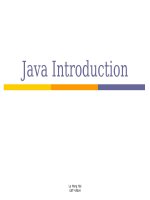Dessler HRM 12e ch 01 introduction
Bạn đang xem bản rút gọn của tài liệu. Xem và tải ngay bản đầy đủ của tài liệu tại đây (793.73 KB, 36 trang )
Chapter 1
Introduction to
Human Resource
Management
Part One | Introduction
Copyright © 2011 Pearson Education, Inc.
publishing as Prentice Hall
PowerPoint Presentation by Charlie Cook
The University of West Alabama
WHERE WE ARE NOW…
Copyright © 2011 Pearson Education, Inc. publishing as Prentice Hall
1–2
LEARNING OUTCOMES
1. Explain what human resource management is and how
it relates to the management process.
2. Show with examples why human resource management
is important to all managers.
3. Illustrate the human resources responsibilities of line
and staff (HR) managers.
4. Briefly discuss and illustrate each of the important
trends influencing human resource management.
5. List and briefly describe important trends in human
resource management.
6. Define and give an example of evidence-based human
resource management.
7. Outline the plan of this book.
Copyright © 2011 Pearson Education, Inc. publishing as Prentice Hall
1–3
Human Resource Management at
Work
• What Is Human Resource Management (HRM)?
The process of acquiring, training, appraising, and
compensating employees, and of attending to their labor
relations, health and safety, and fairness concerns.
• Organization
People with formally assigned roles who work together to
achieve the organization’s goals.
• Manager
The person responsible for accomplishing the organization’s
goals, and who does so by managing the efforts of the
organization’s people.
Copyright © 2011 Pearson Education, Inc. publishing as Prentice Hall
1–4
The Management Process
Planning
Controlling
Leading
Copyright © 2011 Pearson Education, Inc. publishing as Prentice Hall
Organizing
Staffing
1–5
Human Resource Management
Processes
Acquisition
Training
Fairness
Health and Safety
Human
Resource
Management
(HRM)
Labor Relations
Copyright © 2011 Pearson Education, Inc. publishing as Prentice Hall
Appraisal
Compensation
1–6
Personnel Aspects of a Manager’s
Job
• Conducting job analyses
• Planning labor needs and recruiting job candidates
• Selecting job candidates
• Orienting and training new employees
• Managing wages and salaries
• Providing incentives and benefits
• Appraising performance
• Communicating
• Training and developing managers
• Building employee commitment
Copyright © 2011 Pearson Education, Inc. publishing as Prentice Hall
1–7
Personnel Mistakes
• Hire the wrong person for the job
• Experience high turnover
• Have your people not doing their best
• Waste time with useless interviews
• Have your firm in court because of discriminatory actions
• Have your firm cited by OSHA for unsafe practices
• Have some employees think their salaries are unfair and inequitable
relative to others in the organization
• Allow a lack of training to undermine your department’s
effectiveness
• Commit any unfair labor practices
Copyright © 2011 Pearson Education, Inc. publishing as Prentice Hall
1–8
Basic HR Concepts
• The bottom line of managing:
Getting results
• HR creates value by engaging in activities that
produce the employee behaviors that the
organization needs to achieve its strategic goals.
• Looking ahead: Using evidence-based HRM to
measure the value of HR activities in achieving
those goals.
Copyright © 2011 Pearson Education, Inc. publishing as Prentice Hall
1–9
Line and Staff Aspects of HRM
• Line Manager
Is authorized (has line authority) to direct the work of
subordinates and is responsible for accomplishing the
organization’s tasks.
• Staff Manager
Assists and advises line managers.
Has functional authority to coordinate personnel activities
and enforce organization policies.
Copyright © 2011 Pearson Education, Inc. publishing as Prentice Hall
1–10
Line Managers’ HRM
Responsibilities
1. Placing the right person on the right job
2. Starting new employees in the organization (orientation)
3. Training employees for jobs that are new to them
4. Improving the job performance of each person
5. Gaining creative cooperation and developing smooth
working relationships
6. Interpreting the firm’s policies and procedures
7. Controlling labor costs
8. Developing the abilities of each person
9. Creating and maintaining department morale
10. Protecting employees’ health and physical condition
Copyright © 2011 Pearson Education, Inc. publishing as Prentice Hall
1–11
Human Resource Managers’ Duties
Functions of
HR Managers
Line Function
Line Authority
Implied Authority
Coordinative
Function
Functional Authority
Copyright © 2011 Pearson Education, Inc. publishing as Prentice Hall
Staff Functions
Staff Authority
Innovator/Advocacy
1–12
FIGURE 1–1
Human Resources Organization Chart for a Large Organization
Copyright © 2011 Pearson Education, Inc. publishing as Prentice Hall
1–13
FIGURE 1–2
Human Resources Organization Chart for a Small Company
Copyright © 2011 Pearson Education, Inc. publishing as Prentice Hall
1–14
Human Resource Specialties
Recruiter
Labor relations
specialist
EEO coordinator
Human
Resource
Specialties
Job analyst
Training specialist
Compensation
manager
Copyright © 2011 Pearson Education, Inc. publishing as Prentice Hall
1–15
New Approaches to Organizing HR
New HR Services Groups
Transactional HR
group
Corporate
HR group
Copyright © 2011 Pearson Education, Inc. publishing as Prentice Hall
Embedded
HR unit
Centers of
Expertise
1–16
Trends Shaping Human Resource
Management
Globalization
and Competition
Trends
Indebtedness
(“Leverage”) and
Deregulation
Technological
Trends
Trends in HR
Management
Workforce and
Demographic
Trends
Trends in the
Nature of Work
Economic
Challenges and
Trends
Copyright © 2011 Pearson Education, Inc. publishing as Prentice Hall
1–17
FIGURE 1–4
Trends Shaping Human Resource Management
Copyright © 2011 Pearson Education, Inc. publishing as Prentice Hall
1–18
FIGURE 1–5
Employment Exodus: Percent of employers who said they
planned as of 2008 to offshore a number of these jobs
Copyright © 2011 Pearson Education, Inc. publishing as Prentice Hall
1–19
Trends in the Nature of Work
Changes in How We Work
High-Tech
Jobs
Service
Jobs
Copyright © 2011 Pearson Education, Inc. publishing as Prentice Hall
Knowledge Work
and Human Capital
1–20
TABLE 1–1
Demographic Groups as a Percent of the Workforce, 1986–2016
Copyright © 2011 Pearson Education, Inc. publishing as Prentice Hall
1–21
Workforce and Demographic
Trends
Demographic Trends
Trends Affecting
Human Resources
Generation “Y”
Retirees
Nontraditional Workers
Copyright © 2011 Pearson Education, Inc. publishing as Prentice Hall
1–22
FIGURE 1–6
Gross National Product (GNP)
Copyright © 2011 Pearson Education, Inc. publishing as Prentice Hall
1–23
FIGURE 1–7
Case-Shiller Home Price Indexes
Copyright © 2011 Pearson Education, Inc. publishing as Prentice Hall
1–24
Important Trends in HRM
The New HR
Managers
Strategic
HRM
Evidence-Based
HRM
Human
Resource
Management
Trends
High-Performance
Work Systems
Managing
Ethics
HR
Certification
Copyright © 2011 Pearson Education, Inc. publishing as Prentice Hall
1–25









